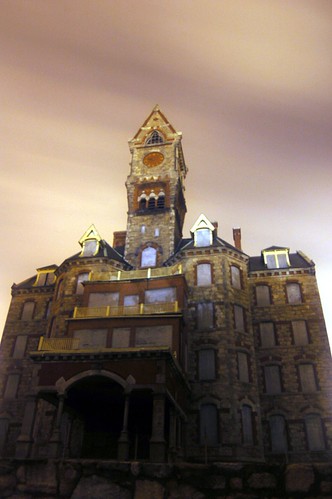The remains of Worcester State Hospital's administration building sits and watches the hustle and bustle of Route 9 and the University of Massachusetts Medical Center. Built on the Kirkbride Model in 1877, it stood for over a hundred years before succumbing to a massive fire in 1991.
It's an iconic building in the area. I was really excited to find this postcard from 1904 that shows it with both wings intact. Kirkbride hospitals (named for their pioneer, Thomas Story Kirkbride) incorporate architectural design into a theory of psychiatric convalescence. Basically, the various wards were staggered in wings that moved diagonally back and away from a central administration building. The idea was that this design would allow the patients to see out the windows and have pleasant views and breezes. As their health improved, they would move toward the central administration building. The women's wings were often much longer than the men's wings, as it was mistakenly thought that women more often suffered from mental ailments. It was probably really just extreme boredom and depression from a society that left them horribly under-stimulated.

When we lived in Worcester, Erin and I visited the ruins of the hospital fairly often. It's a really impressive place. There were once many Kirkbride hospital in the Northeast and Midwest, but most have been destroyed. Some have been repurposed, which is great. About five years ago we took a road trip around the northeast and visited Kirkbride hospitals in New York, Pennsylvania, West Virginia, Maryland, and, of course, Massachusetts. I'll post those pictures sometime when I'm homesick again, but for today, here are some more shots of Worcester State Hospital. To see inside, visit Opacity.



It's an iconic building in the area. I was really excited to find this postcard from 1904 that shows it with both wings intact. Kirkbride hospitals (named for their pioneer, Thomas Story Kirkbride) incorporate architectural design into a theory of psychiatric convalescence. Basically, the various wards were staggered in wings that moved diagonally back and away from a central administration building. The idea was that this design would allow the patients to see out the windows and have pleasant views and breezes. As their health improved, they would move toward the central administration building. The women's wings were often much longer than the men's wings, as it was mistakenly thought that women more often suffered from mental ailments. It was probably really just extreme boredom and depression from a society that left them horribly under-stimulated.

When we lived in Worcester, Erin and I visited the ruins of the hospital fairly often. It's a really impressive place. There were once many Kirkbride hospital in the Northeast and Midwest, but most have been destroyed. Some have been repurposed, which is great. About five years ago we took a road trip around the northeast and visited Kirkbride hospitals in New York, Pennsylvania, West Virginia, Maryland, and, of course, Massachusetts. I'll post those pictures sometime when I'm homesick again, but for today, here are some more shots of Worcester State Hospital. To see inside, visit Opacity.





4 comments:
Awsome postcard.
I'm actually not surprised that women were mistaken for having greater rates of mental illness, but I don't think it was a matter of understimulation. The types of mills and factories that most men worked in during the 19th century wouldn't have served as protective factors. Actually, the early 20th century working conditions portrayed in The Jungle would have served as risk factors for mental illness. I think that a reason that women appeared to have more mental illness had to do with presentation. Even today, women are more likely to be diagnosed with depression and anxiety where as men are more likely to be diagnosed with alcoholism and antisocial disorders. Although the exact cause is unknown, its likely due to the fact that how a person responds to stress and negative emotions is, in part, due to gender stereotypes. Think of which gender would be more "allowed" to cry and be worried and which gender would be more "allowed" to get drunk and fight. Since drinking and rule breaking behavior has been traditionally considered criminal in nature, it gives the appearance that certain types of mental illness is the domain of women. There is an article by the World Health Organization on gender and mental illness at
http://www.google.com/url?sa=t&source=web&ct=res&cd=1&ved=0CAsQFjAA&url=http%3A%2F%2Fwww.who.int%2Fmental_health%2Fprevention%2Fgenderwomen%2Fen%2F&rct=j&q=gender+and+mental+illness&ei=WBOCS770F8mklAfL-LWaBw&usg=AFQjCNHMp472F4_1gB-mAMSRJwomECI_Ug
Sorry if that was long, but you hit upon my area of study.
Since the link didn't work in my last post, just good "Gender and women's mental health"
In that last post, I ment Google, not good. A clear sign that I should get off the internet and go to bed.
That's very interesting. I know that working class women were less likely to institutionalized because their families couldn't afford treatment. Also, the standards for institutionalizing women were lower - if a daughter was strong willed or sexually promiscuous, that was grounds for sending her to the asylum. Not so for boys.
I'll have to check that link out. It sounds really interesting.
Post a Comment